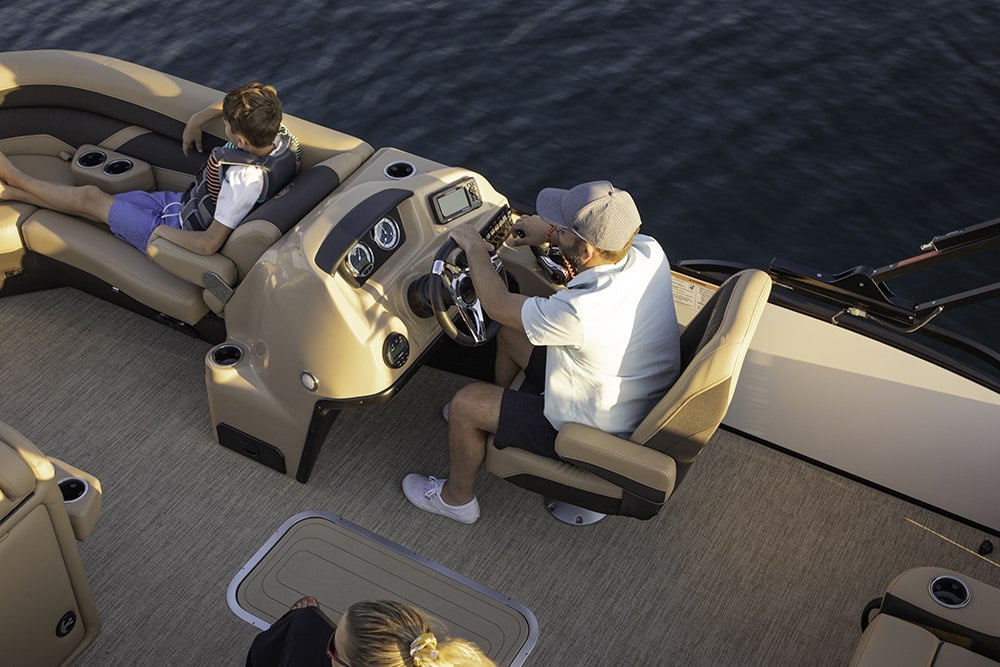Steering Options for Pontoon Boats (Which is Best for You?)
Let’s say you have your heart set on a pontoon boat. You’re looking forward to a summer filled with sunset cruises, sandbar floating, and entertaining your friends and family.
While you research your new boat, you find that there are a few options that have left you wondering, what do I choose?
If you’re anything like me, I purchased my Barletta pontoon boat because of the floorplan, size, amenities, service after the sale, and design. I fell in love with my boat, and it was a no-brainer.
However, there were a few features that were an afterthought, and I’m so glad Barletta built the boat with a lot of thoughtful consideration when it came to one major feature: steering.
I have a large engine on a rather hefty tritoon, and luckily the boat was upgraded to a type of steering that would allow me to turn the wheel with a flick of the wrist even in choppy waters and hard turns.
Before I joined the Barletta team, I did not realize how important steering options are. They can make or break your on-water experience if you don’t know what you’re choosing.
I hope to give you some clarity on which option will be right for you. I’m going to explain the big three and how they will affect your boat’s drivability.
- Mechanical steering - Good
- Hydraulic steering - Better
- Power assist hydraulic steering - Best
1. Mechanical Steering
Mechanical steering is the most basic type of steering offered. If you are part of a more mature generation, you may have had a car in the past that did not have power steering, this is similar.
This type of steering uses a rotary gear system at the helm to push/pull a cable, which steers the engine. It makes turning difficult if you have a large engine and a heavy boat.
Mechanical steering is the most cost-effective option, and you will find this standard on bitoons. This type of steering is not available on Barletta tritoons due to interferences with the motor pod.
Most manufacturers will recommend upgrading from mechanical steering starting around 115HP and force you out of the mechanical steering once you hit 150HP. That’s because larger engines are heavier and, in turn, harder to manipulate manually.
Greater speeds also make turning the wheel harder. So if you have a heavy and fast pontoon boat, mechanical steering can become a dangerous option for those who don’t have the strength to do the heavy lifting necessary to turn the boat.
The motor also has a natural tendency to turn one direction because of the propeller rotation, this can add to the difficulty of being able to pull the boat out of a turn.
That said, if you plan on purchasing a bitoon floorplan with a smaller engine, this is a cost-effective option. You should be prepared to know that the boat will steer like a car that has no power steering.
2. Hydraulic Steering
Hydraulic steering is the second-tier option. It’s the immediate upgrade from mechanical steering and is typically found on pontoons that have a 115HP engine or greater and is standard on tritoons.
This type of steering uses a pump at the helm, hydraulic fluid, hoses, and a steering cylinder at the engine. When you turn the wheel, hydraulic fluid moves through a series of valves in the helm pump and out through the hoses to the steering cylinder.
All of that to say, the hydraulic fluid moving back and forth makes it very easy to do a lot of heavy lifting on the outside without a lot of effort on the input.
Compared to mechanical steering, hydraulic steering greatly reduces the effort needed to steer the boat safely and pull it in and out of turns. That said, you will still have some resistance as it’s not the highest-grade steering option available.
If you have any doubt in your mind that you may not like mechanical steering, I do recommend upgrading to hydraulic. It will be a noticeable difference.
If you’re cruising straight most of the time and have the strength to work through some resistance while turning, you could make hydraulic work, and it is more cost-effective than its upgrade, power assist hydraulic.
As I mentioned, hydraulic steering comes standard on tritoons. To upgrade to this option on a bitoon, you’re looking at a ballpark price of around $1,500. I can tell you from personal experience, it’s worth the money.
3. Power Assist Hydraulic Steering
If you’re looking for the cream of the crop when it comes to steering options, look no further than power assist hydraulic steering.
This is the same as the hydraulic steering system with an extra pump added. The extra hydraulic pump helps push the fluid back and forth through the system, doubling the amount of assistance you get when turning the wheel.
This type of steering is noticeably different than hydraulic steering and requires minimal effort on the input to steer the boat. It’s a perfect choice if you’re looking for an easy driving experience.
Regardless of the size of the engine or the weight of the boat, you can steer with only a couple of fingers. This is optimal for cruising at high speeds, taking the kids tubing, or just safely boating through crowded bodies of water.
Most manufacturers recommend upgrading to power assist hydraulic steering around 200HP and some begin to force it at 250HP.
The ballpark upgrade price for this type of steering is going to be around $3,000. If you are buying a big floorplan with a large engine, I recommend exploring this option. It will give you that automotive power steering feel.
There has been a recent development for the pontoon industry that is a supplement to power assist hydraulic steering. Digital electric steering is now available through some pontoon manufacturers, so talk to your dealer about this option if you’re interested.
The advantage is that it can be controlled by a joystick for close-quarter maneuverability. It is a direct replacement for power assist hydraulic steering on single-engine boats and possesses many of the same qualities in regards to usability.
Food for Thought
Most manufacturers are making the decision to upgrade to these different steering options for you based on safety, expected performance of the boat, and cost. Check out this video where Barletta VP of Sales Jeff Haradine explains the differences between these three steering options.
Pontoon Steering Options Explained
I strongly suggest test driving different steering options if you’re still unsure which is best for you. There’s nothing more disappointing than purchasing a boat and having the performance fall short of your expectations because of the steering choice.
Something else to keep in mind is that different boat types perform differently even in the same steering category. Don’t compare your bass boat without hydraulic steering and think that it will be the same on a pontoon.
There are so many factors that affect these steering types differently between different makes and models; the weight of the boat, planes out quickly, lots of turns, busy lake, engine size, driving speeds, etc.
Upgrading from mechanical to either hydraulic or power assist hydraulic will also impact the ease of maneuvering the boat around the dock. If you already have trouble parking the boat, mechanical steering will make it that much more difficult.
The steering you choose will impact how the boat performs. This sometimes goes overlooked if the buyer is unaware of the impact upgraded steering options can make.
Talk to your dealer about your options and test drive if you can. It will be worth your time and effort.



.png?width=700&name=BUILD%20(2).png)